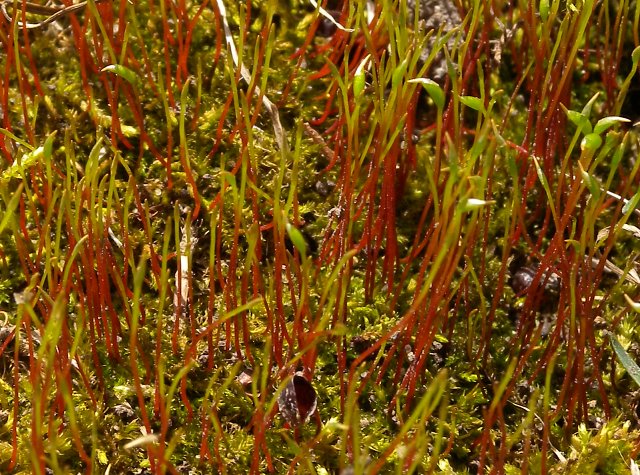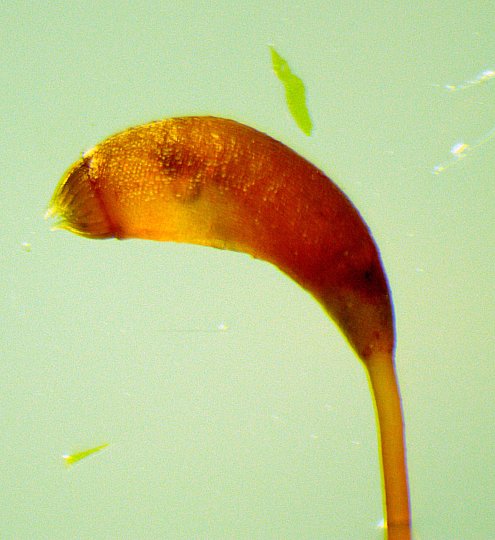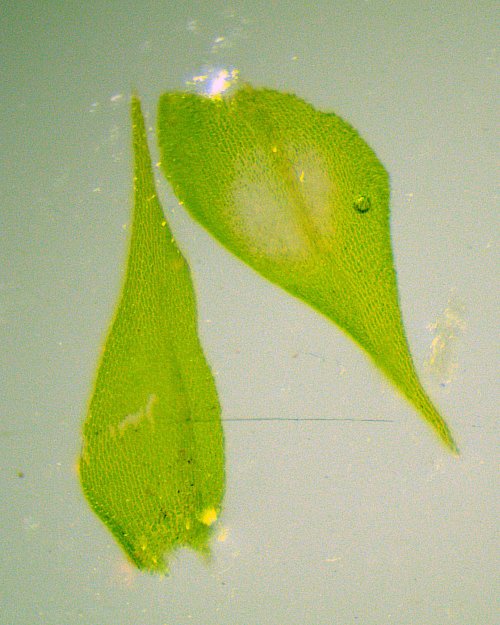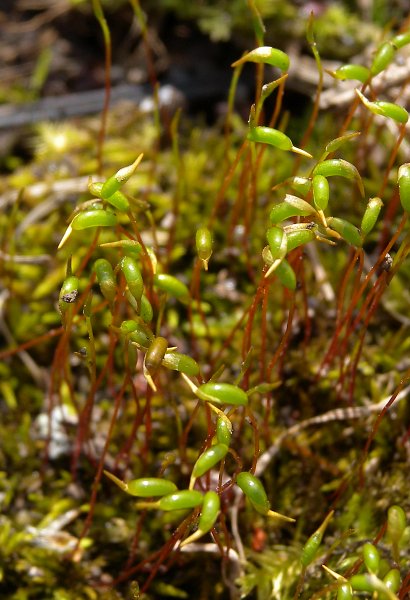
The leaf surface is light green to golden yellow (the latter color is more likely to occur under dry sunny conditions). The leaves have solitary midribs that extend from their bases to 35–75% of their length. Leaf cells are irregularly quadrate (4-angled) near the leaf bases, otherwise they are more angular-oblong in shape. This moss is monoicous, producing male reproductive organs and female reproductive organs on the same plant; they are often located close together. As a result, sporophytes are commonly produced during the spring. Each sporophyte consists of a spore-bearing capsule at the apex of a seta (slender stalk). The setae are light yellowish green while they are immature, but becoming more red as they mature; they are more or less erect, slender, and smooth. The body of a relatively mature spore-bearing capsule is 1.5–2 mm. long with an arched cylindrical-oblanceoloid shape. The lid (operculum) of the capsule body is 0.5 mm. long and short-conical in shape. Both the capsule body and lid are initially light green, but they later become red to reddish brown. After the lid detaches from the capsule body and falls to the ground, a ring of inwardly curved triangular teeth is revealed; these teeth (peristome) are reddish at their bases, becoming yellowish at their tips. A white-membranous hood (calyptra) with a moderately long beak initially covers the upper capsule body and lid, but it soon splits apart and falls to the ground.

The spores of the capsule body are released to the wind. Individual spores are 12-15 micrometers across, globoid in shape, and finely bumpy (papillose). Reddish-brown fibrous rhizoids are produced in clusters along the lower sides of stems; they help to anchor the stems of this moss to the substrate. This moss can reproduce asexually when a disturbance of some kind creates fragments of leafy stems. These fragments are able to develop their own rhizoids along the undersides of their stems.
Cultivation: The preference is light to medium shade, moist to mesic conditions, and a substrate consisting of soil, humus, or rotting wood.

Range & Habitat: The native Creeping Feather Moss (Amblystegium serpens) is common in the northern half of Illinois, while in the southern half of the state it is occasional (see Distribution Map). This moss is undoubtedly more common than these distribution records indicate, however. Creeping Feather Moss is widely distributed around the world, including North America, South America, Eurasia, Australia, and northern Africa. In Illinois, this moss is found in such habitats as ground soil in deciduous woodlands, ground soil near woodland paths, rotten logs and decaying fallen branches in woods, ground soil in swamps, rotten logs in swamps, lower trunks of trees in wooded areas, ground soil at the base of mature trees, shaded ground on wooded slopes, shaded slopes and bottoms of ravines, exposed rocks along woodland streams, earthen banks and bottoms of intermittent streams, shaded sandstone and limestone cliffs, wet ground in quarries, wet spoil banks from dredging or mine operations, shaded banks of ponds in city parks, shaded ground soil along buildings, shaded ground near parking lots, and shaded edges of yards. Outside of Illinois, this moss has been found near lighted cave entrances. Creeping Feather Moss occurs in highly disturbed areas to high quality natural areas. It is fairly common and rather weedy overall.

Faunal Associations: A mite, Eustigmaeus frigida, oviposits and feeds on this moss (Glime, 2017f). Several songbirds use Creeping Feather Moss (Amblystegium serpens) as construction material for their nests; these bird species include the Eastern Phoebe, American Robin, Least Flycatcher, and Dark-eyed Junco (Breil & Moyle, 1976). As a result of this activity, these songbirds may spread this moss to new areas because fragments of its leafy stems are able to reestablish themselves as clonal plants.
Photographic Location: Shaded edge of a yard at the webmaster's apartment complex in Urbana, Illinois.

Comments: Many moss species that were once assigned to the Amblystegium genus have been reassigned to Hygroamblystegium and other genera in the Feather Moss family (Amblystegiaceae). In addition, some former species in the Amblystegium genus have been discarded as insignificant forms of Creeping Feather Moss (Amblystegium serpens) and other similar species. As a result, this moss is rather variable across its worldwide range. These variations include differences in the size and width of individual leaves, the extent to which the leaves are divergent from their stems, and the length of the midribs in relation to the length of their leaves. Occasionally, field specimens are encountered that do not fit neatly into any of the current classification systems for this group of mosses. Creeping Feather Moss is probably most similar to another common species, Tangled Feather Moss (Amblystegium varium, Hygroamblystegium varium). This latter moss species differs by having slightly larger leaves (1-2 mm. long), prominent leaf midribs that extend nearly to the leaf tips, and slightly longer spore-bearing capsule bodies (2–2.5 mm. long). Otherwise, these two species are very similar to each other in appearance, and they seem to prefer similar habitats, although Tangled Feather Moss may prefer habitats that are a little more wet.